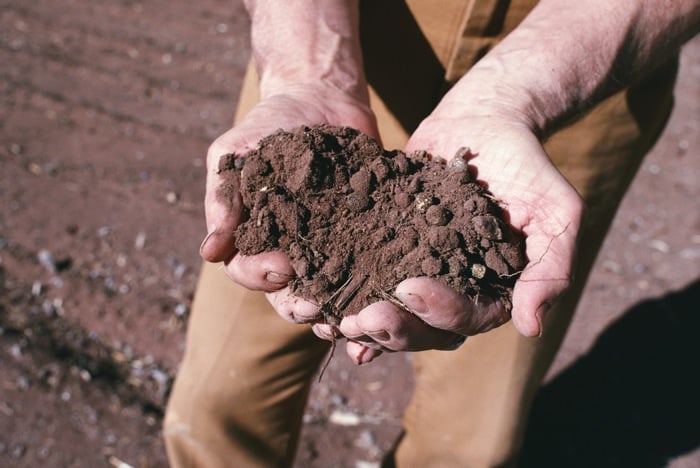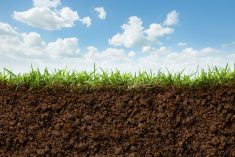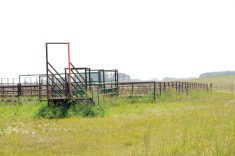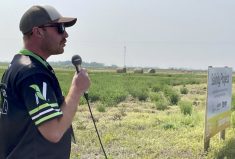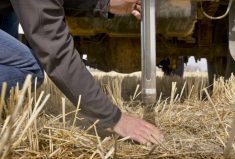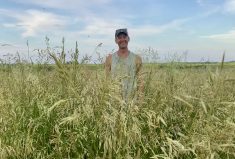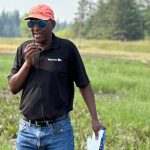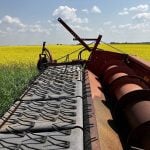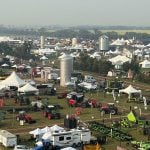In Bruce Feiler’s book entitled Walking the Bible, he has a discussion with his travel partner Avner as they were tightly squeezed into a nawamis, or tiny tomb, that pastoralists used 6,000 years ago as they made their way around the desert.
Avner said, “Those in agricultural areas used technology to change the world around them. They changed it by plowing, seeding, planting, domesticating animals. The strategy of the pastoralists was to adapt themselves to the environment. That is why all their tombs face east, for example, to get warm as early as possible in the morning.”
Read Also

Hail research hopes to benefit potato growers
Alberta research scientist measures hail storm and heat dome affects on potato crops
The discussion based on the split of communities based on core beliefs are not too far off what we encounter today when we try to talk about soil and forage health versus conventional grain farming. During my entire career, there has been a philosophical divide between farmers and pastoralists (ranchers).
Take, for example, the continuing debate on grass- versus grain-fed beef. Those in the grass camp understand that grass is a carbon sink, which has recently been proven to be of more might than trees. The value of that sink (a carbon sink is when more carbon is captured or sequestered compared to what is released) on Canadian Prairies has a value of $231.18 per acre. Using what is already there to produce food seems simply natural. There is a codependency on rain and heat and at the core is maintaining the original soil health, or improving it. Manure, nature’s fertilizer, adds $127.40 per acre on the average ranch, not only fertilizing soil, but also attracting the right bugs and birds needed for the biodiversity on the land.
- More with Brenda Schoepp on the Alberta Farmer: The cattle industry hasn’t fully embraced animal welfare
Using technology to change the world around him has long been man’s mission. The desire to produce greater volumes and variety of food has been served well by the use of science and technology. Our ability to feed the world is because of constant invention. The result is also a landscape changed and a soil profile that is challenged. No doubt, as we continue to stress the soil, man will also find ways to fix the problem. To the pastoralist this is a terminal exercise.
For beef, massive production of feed grains because of innovation and technology means that animals are the way to “sell” the product. It will be hard to get a large-scale grain farmer to think in terms of grass-fed beef when he “needs” a livestock industry to value add to his grain.
In North America, grain production and livestock feeding are intertwined. In addition, the land required to meet the current needs of the market today would be somewhat staggering if grazing was the only option. It may seem then there is a lean in this story toward the grazier but as in all things, the responsibility lies throughout the production chain.
Beef farmers, too, forgot the importance of soil and of its needs when we went to Cadillac cows. Man has become the foragers for the cows and in doing so has taken the cow, a self-driven low-input converter of marginal land and trash and turned her into a high-input resident of expensive space. The practice of housing and feeding in one spot has negative effects on soil and can be dangerous to plant and human health. Although weather conditions dictate some density in terms of housing and feeding, it hardly justifies the communal pen that so many farms now sport.
And what of the rest of society? How have their expectations evolved when it comes to food animals?
It is pretty clear there is an expectation of sameness with every bite and that plays a stressful role in soil health. Increased urbanization also gobbles up good soil, and pollution keeps the lungs of soil working overtime. From compaction in the field to the overfertilization of a balcony planter, each member of all of society has a strong role in soil health.
Sitting on a hill in the Holy Land debating the history of pastoralists and farmers will not create solutions but 6,000 years later we are finally talking about soil from an international perspective. This year is the UN’s International Year of Soils and our chance to participate in bringing awareness about the importance of healthy soil and its relationship to plant, animal and human health.
Perhaps one day we may get to the point made by author Dan Barber when he said that we don’t need to support the nation’s farmers, we need to support the soil that supports the farmers and ranchers. In doing so, we create an equitable and everlasting solution.


